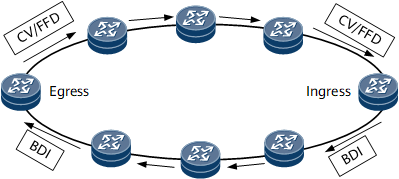Overview of MPLS OAM
Definition
As a key technology used on scalable next generation networks, Multiprotocol Label Switching (MPLS) provides multiple services with quality of service (QoS) guarantee. MPLS, however, introduces a unique network layer, which causes faults. Therefore, MPLS networks must obtain operation, administration and maintenance (OAM) capabilities.
OAM is an important means to reduce network maintenance costs. The MPLS OAM mechanism manages operation and maintenance of MPLS networks.
For details about the MPLS OAM background, see ITU-T Recommendation Y.1710. For details about the MPLS OAM implementation mechanism, see ITU-T Recommendation Y.1711.
Purpose
The server-layer protocols, such as Synchronous Optical Network (SONET)/Synchronous Digital Hierarchy (SDH), is below the MPLS layer; the client-layer protocols, such as IP, is above the MPLS layer. These protocols have their own OAM mechanisms. Failures in the MPLS network cannot be rectified completely through the OAM mechanism of other layers. In addition, the network technology hierarchy also requires MPLS to have its independent OAM mechanism to decrease dependency between layers on each other.
The MPLS OAM mechanism can detect, identify, and locate a defect at the MPLS layer effectively. Then, the MPLS OAM mechanism reports and handles the defect. In addition, if a failure occurs, the MPLS OAM mechanism triggers protection switching.
MPLS offers an OAM mechanism totally independent of any upper or lower layer. The following OAM features are enabled on the MPLS user plane:
Benefit
- MPLS OAM can rapidly detect link faults or monitor the connectivity of links, which helps measure network performance and minimizes OPEX.
- If a link fault occurs, MPLS OAM rapidly switches traffic to the standby link to restore services, which shortens the defect duration and improves network reliability.
Basic Detection Functions
MPLS OAM can be used to check the connectivity of an LSP.
Figure 1 shows connectivity monitoring for an LSP.
The working process of MPLS OAM is as follows:
The ingress sends a connectivity verification (CV) or fast failure detection (FFD) packet along an LSP to be monitored. The packet passes through the LSP and arrives at the egress.
The egress compares the packet type, frequency, and trail termination source identifier (TTSI) in a received packet with the locally configured values to verify the packet. In addition, the egress collects the numbers of correct and incorrect packets within a detection interval.
If the egress detects an LSP defect, it analyzes the defect type and sends a backward defect indication (BDI) packet carrying defect information to the ingress along a reverse tunnel. The ingress can then obtain the defect. If a protection group is correctly configured, the ingress switches traffic to a backup LSP.
Reverse Tunnel
A reverse tunnel is bound to an LSP that is monitored using MPLS OAM. The reverse tunnel can transmit BDI packets to notify the ingress of an LSP defect.
A reverse tunnel and the LSP to which the reverse tunnel is bound must have the same endpoints.
The reverse tunnel transmitting BDI packets can be either of the following types:
MPLS OAM Auto Protocol
ITU-T Recommendation Y.1710 has some drawbacks, for example:
If OAM is enabled on the ingress of an LSP later than that on the egress or if OAM is enabled on the egress but disabled on the ingress, the egress generates a loss of connectivity verification defect (dLOCV) alarm.
Before the OAM detection packet type or the interval at which detection packets are sent are changed, OAM must be disabled on the ingress and egress.
OAM parameters (such as a detection packet type and an interval at which detection packets are sent) must be set on both the ingress and egress, which may cause parameter inconsistency.
The NetEngine 8000 F implements the OAM auto protocol to resolve these drawbacks.
The OAM auto protocol is configured on the egress. With this protocol, the egress can automatically start OAM functions after receiving the first OAM packet. In addition, the egress can dynamically stop running the OAM state machine after receiving an FDI packet sent by the ingress.
